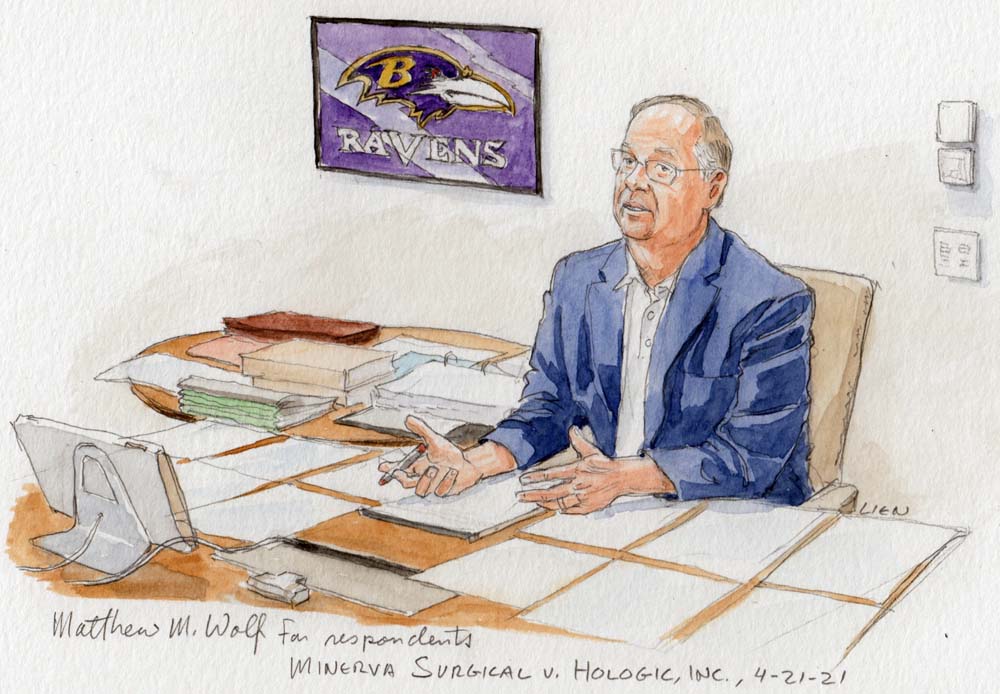Argument analysis
Doctrinal “dinosaur” or stare decisis? Justices wrestle with patent-law precedent.

on Apr 23, 2021 at 5:45 pm

The justices explored possible ways to limit the doctrine of patent assignor estoppel during oral argument in Minerva Surgical Inc. v. Hologic Inc. on Wednesday.
The doctrine works like this. An inventor files a patent application on an invention and assigns the patent rights to an assignee — perhaps in exchange for money from the assignee, or perhaps as part of a contract with the inventor’s employer. After a patent issues, the assignee contends that the inventor has infringed the patent. In the patent-infringement lawsuit, the inventor wants to argue that the patent is invalid. The doctrine of assignor estoppel bars the inventor from challenging validity. It stems from concerns that every assignment of patent rights involves implicit representations about patentability, and the inventor should not be able to contradict those representations and undermine the value of the assigned patent rights.
Minerva, which makes medical devices, seeks to abolish the doctrine. It has been accused of infringing patented technology invented by the company’s founder and wants to avoid liability for patent infringement. Hologic, a competitor, seeks to maintain the doctrine. It holds the assigned rights to the patent and sued Minerva for patent infringement.

Robert Hochman argues for Minerva Surgical Inc. (Art Lien)
Although no strong consensus emerged at argument, the justices seemed reluctant either to abandon the doctrine altogether or to preserve it as is. Most of the argument concerned the middle ground, where the doctrine could continue to exist in a narrow form. Six of the nine justices asked counsel for Minerva or Hologic about ways to limit the doctrine, and five of them specifically asked about the federal government’s proposed limitations, which I covered earlier this week.
Robert Hochman, who argued for Minerva, called assignor estoppel a “doctrinal dinosaur” and opened with an appeal to textualists: “The Patent Act doesn’t provide for assignor estoppel and never has.” But the justices did not seem prepared to completely jettison the doctrine. Hochman fielded several questions about why the court should abandon a doctrine that the court has recognized for nearly a century.
Justice Elena Kagan asked about “the core application of assignor estoppel,” where an inventor obtains a patent, sells the patent, and then argues that the invention was obvious and not patentable. Hochman conceded that this hypothetical inventor cannot assert invalidity, but tried to rely on other doctrines to explain why.
Taking a different approach, Justice Clarence Thomas pointed out that the Patent Act does not mention claim preclusion or issue preclusion, but those doctrines nevertheless bar certain arguments in patent litigation.
Morgan Ratner argued for the federal government, which filed its own friend-of-the-court brief but supported neither party. The justices pressed Ratner on where the government’s version of the doctrine came from. As Justice Neil Gorsuch put it, “No court’s ever applied the version of estoppel that you’re proposing now.” Or from Justice Stephen Breyer, “I can understand abolishing it. I can understand keeping it. But limiting it, I’m finding trouble in finding the right way to do that.”
Matthew Wolf argued for Hologic. Wolf principally argued that stare decisis justifies maintaining the doctrine. But the justices pressed Wolf on just how firmly established the doctrine really is. Chief Justice John Roberts suggested that “it’s not the strongest stare decisis argument” in light of Supreme Court decisions characterizing the doctrine as a failure.
The justices also pressed Hologic on why the doctrine should apply in all cases. In particular, the justices seemed to be troubled by the common scenario in which an employee signs a general assignment of all inventions to her employer as part of her employment contract. Under the current version of the doctrine, the employee could be barred from ever challenging the validity of a patent that her employer pursued. The justices were also concerned about situations in which there is no inconsistency between the assignor’s implicit representation about validity and the assignor’s later invalidity challenge. This situation may arise, for example, when an assignee broadens the scope of the patent after the assignment and obtains a patent broader than what the assignor thought patentable at the time of assignment.
The justices will have to sort through several major themes: the role of stare decisis, the uncertainty about assignor estoppel in the court’s own cases, and how to set appropriate limits on the doctrine. Although the justices did not seem eager to abandon assignor estoppel, they likely will not embrace a broad version of the beleaguered doctrine.


